#there is probably a better term than form motif but u know what I mean
Text
🚨LOVER BOY LATEST🚨letters and notes and cards and handwritten messages are becoming a Form Motif
#there is probably a better term than form motif but u know what I mean#a motif relating to the form#I still have a big Oxford glossary of literary terms that I got for uni and have never opened#what if I read it for fun heheeeee#anyway I knew this was a thing but they keep popping up naturally#the ones in my head rn…..OOOOOFFFFFF!!!! THEY HURT!!!!
2 notes
·
View notes
Text
Hymnstoke XIV
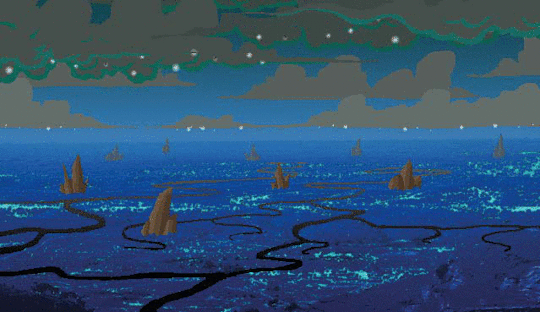
Like Act 2, Act 4 opens with a walkaround game.
I didn't comment much on the game at the beginning of Act 2, despite it being one of those much-discussed multimedia elements that make Homestuck so distinctive. In Act 2, the movement from linear story to game serves several purposes. First, it demonstrates an increase in scope, both in terms of Homestuck's story and in relation to Hussie's previous effort, Problem Sleuth. While Act 1 incorporated a couple of new elements not seen in other MSPA comics, such as protagonists capable of speech and a handful of simple videos, the Act 2 walkaround is the first dramatic increase in what readers could have reasonably expected from the comic at the time.
Secondly, the novel concept of incorporating a game into the story corresponds to and emphasizes the novel concept of SBURB within the narrative of Homestuck. Just as the world in which John now finds himself is completely new and unexpected, so too are the readers introduced to this world through a new and unexpected medium. This world is even called the "Medium"—and surrounding a space (Skaia) described as a crucible of pure creation. I previously discussed the significance of SBURB's geography in regards to Gnosticism, but one could also interpret it as a statement on Homestuck as a creative enterprise. A crucible of pure creation through which a new world, or a new mode of expression, will be built. Like how John and friends attempt to create a new world from the fragments of the old, Hussie creates a new kind of story from the fragments of all types of storytelling that came before it. Image, text, video, sound, game—Homestuck strings together these disparate modes of expression into an original creation. In short, the method by which Homestuck is presented mirrors its explicit thematic content.
Wikipedia defines phenomenology as "the philosophical study of the structures of experience and consciousness." Remember how I mentioned that the modernists were often concerned with the conscious and subconscious, and how many attempted to reach truth by depicting the subconscious? Similar concept here.
I was introduced to the term "phenomenology" in relation to art history. In particular, my professor applied the term to modernist painting and sculpture that was designed so that the act of experiencing it changes its meaning. Let's take the following sculpture:
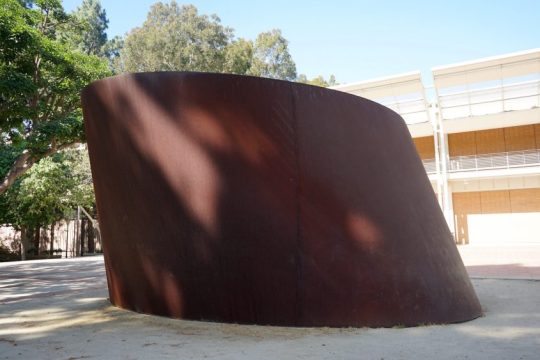
"Sculpture?" you may ask. Yes, I know. It looks more like a misshapen industrial structure. The problem with this sculpture is that no single photograph can truly depict it. Here's the same sculpture from a different vantage:

Another:

Still another:

Top down:

Is this sculpture broader at the bottom or at the top? What shape is it, exactly? You can find this sculpture at the University of California, Los Angeles, and you can even go inside it through the opening visible in some of the photographs. Inside, it takes on a completely different appearance, although unfortunately I couldn't find any good pictures of the inside that didn't have a gigantic Getty Images watermark on them.
In art, this phenomenological experience often boils down to optical illusion or a similar technical trick that appears novel at first but lacks much substance beyond its presentation. What meaning can we derive from this experiment or others like it?
I believe that the phenomenological creations of the modernists eventually reached an apotheosis in a more contemporary form of creative expression: Video games.
The way the player perceives a video game, even a video game you might consider simplistic or linear, is directly affected by how the player plays the game. Take, say, Super Mario Bros. (1985) for the Nintendo Entertainment System. In this game, the player moves Mario left to right to reach a fixed goal. But even this game is affected immensely by the innumerable choices each player makes in playing the game. For an extreme example, compare how a speed run of Super Mario Bros. looks compared to any casual experience of the game. Some elements of the speed run even involve elements assuredly not intended by the game's creator (glitches, for instance). But even at a less extreme level, every player's experience of Super Mario Bros. will differ depending on the routes they take to reach the end, the strategies they employ to evade obstacles, or even the amount of times they die before finally succeeding.
Why do I bring this up? The concept of phenomenology ties into Homestuck's "reader participation" elements, both via the prompt suggestions early on and the more psychological effect the fandom has on Homestuck's development in its back half. Of these two "reader participation" elements, the latter is the one that is probably better described as "phenomenological," in that it is the readership's perspective of Homestuck that eventually drives its trajectory (as opposed to the prompt suggestions, from which Hussie could pick and choose at will). In the back half of Homestuck, the narrative plays more and more on the author's interpretation of the readership's interpretation of the narrative, becoming a perspectival mobius double reach-around where the true driver of the narrative's creation becomes increasingly unclear.
But more specifically, I want to discuss this walkaround game at the beginning of Act 4 in particular. Compared to the one at the beginning of Act 2, this walkaround is not increasing Homestuck's scope. John is entering a new location, but the experience is less novel than entering the Medium in Act 2, both in terms of John's perspective and the reader's. While the Act 4 walkaround features mechanical improvements (inventory, combat) over the Act 2 walkaround, it is still essentially the same thing: a video game. The reader has seen this before in Homestuck. It's not new.
I cannot speak for the experience of every reader, but each time I read Homestuck I am tempted to skip this walkaround entirely. The combat mechanics are banal, the camera is zoomed too close to John to allow for satisfying exploration of an unfamiliar world. In Act 2, the walkaround takes place in an area with which the reader is already geographically acquainted (John's house), so the camera issues are less apparent. But trying to navigate this twisting maze of blue paths, surrounded on all sides by nondescript rocks and mushrooms, can become frustrating. Even if I consult the supplementary map image, I find it somewhat difficult to figure out where I am and where I'm supposed to go.
Which is just the thing. The reader is not supposed to go anywhere. There is no real resolution to this walkaround. The same, in fact, can be said for every walkaround, and we will continue to get amazingly nonessential walkarounds in the acts to come. What does the reader miss if they skip this Act 4 walkaround? Some tedious exposition on the nature of John's planet, its consorts, its customs. Superfluous W O R L D B U I L D I N G that the Homestuck narrative is quick to forget from henceforth on.
It kind of makes me want to, shall we say, skip to the end.
In Act 5, Vriska and Tavros will discuss how the way one plays a game affects the way the game is perceived. Hardcore speed runner Vriska will take my side of the argument and skip what she can; Tavros, more in line with readers inclined to learn as much about SBURB's lore as possible, will argue instead for assiduously completing every task. This conflict—between speed and lore, content and fluff, meat and candy if you will—eventually becomes the core and final dichotomy of Homestuck. But in Homestuck's later stages, the characters and narrative will apply this dichotomy not to how we experience video games, but how we experience all art—and how we experience our actual lives. I intend to trace that development, and this walkaround serves as a fine introduction.
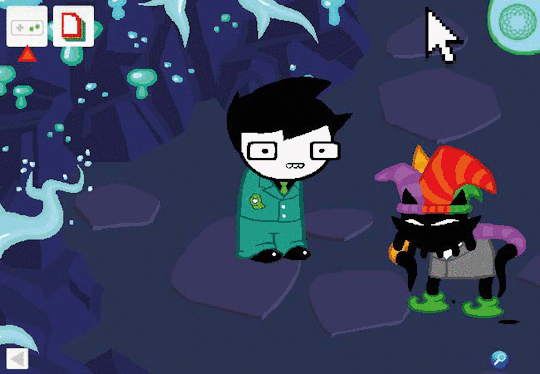
In a few years, Flash will be deprecated and you'll only be able to experience this walkaround through this series of images. I don't know who created these images, or whether laziness or incompetency made them so shitty and SBaHJ-esque. But I give that person props for maintaining that sense of "God this sucks, can I just skip it?" Good job, intern.
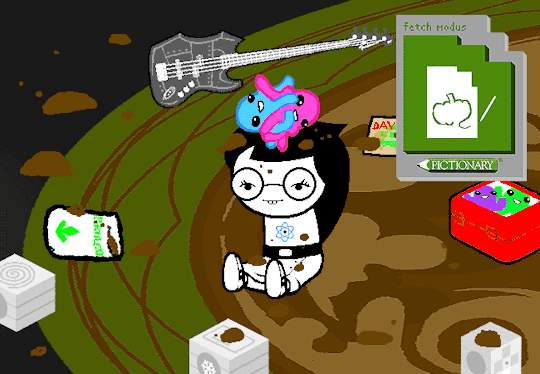
You switch to PICTIONARY, a choice based on a strong whim from the mysterious ethers of democracy.
Another one of those traps, like the suggestion prompts. Wow! The readers get to pick Jade's fetch modus! What an amazing display of reader/author interaction! Except Jade's fetch modus doesn't matter. In fact, as we transition into this next phase of the story, nobody's fetch modus will matter. The fact that all of Jade's possible fetch modii are total jokes only emphasizes the point.
I mentioned in the previous Hymnstoke that we're entering what I'm calling the "clockwork" part of Homestuck. In this part, Homestuck's audience has the least amount of control over its progression. While the suggestion prompts were mostly irrelevant because Hussie could pick whatever prompt he wanted, they occasionally paved actual story or character developments ("Become the mayor of Can Town") or formed memetic jokes that would mutate over the course of Homestuck into part of its mythos. And in Act 6, the immensity of the Homestuck fandom and its increasingly vocal demands will lead to a more subtle transition in what Homestuck becomes—the mobius double reach-around I mentioned previously. But here, in the clockwork part of the story, it's more Hussie than anywhere else. Of course it would be. It's Dirk, Hussie's analogue (connected via a series of motifs like horses and robotics), that comes to represent the Meat side of storytelling, that describes the way a story should be told as a perfect machine. An unfocused, nebulous gaggle of "readers" cannot hope to coordinate among themselves to create something so precise and efficient. Their strengths lie in different directions.
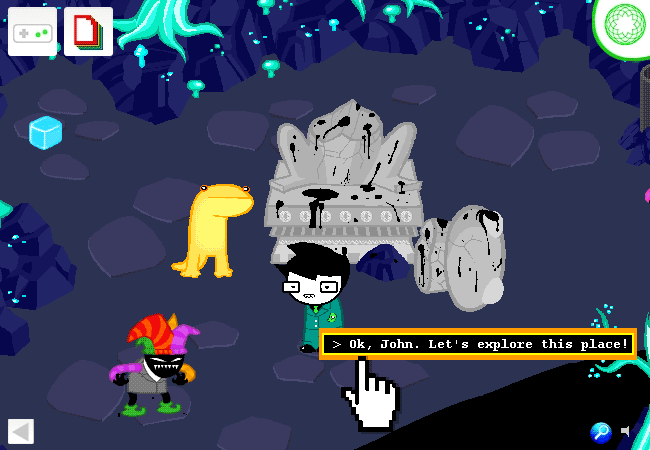
Ok, have at it! If you're at a loss, click the controller button up there.
This may or may not mean anything to you depending on your current perspective.
As it turns out, the story retreads everything that happens in the Act 4 walkaround anyway, making it even less relevant. Even Crumplehat and the Salamander Wizard appear as the walkaround's events are depicted from PM's perspective. This recap is actually pretty extensive, similar to the shitty SBaHJified image walkthrough that got put up in anticipation of Flash's deprecation.
I wonder if Hussie was self-conscious about people's patience for the walkaround? Or maybe he already anticipated Flash would not last forever? Perhaps he added this recap for accessibility reasons, in case of visually-impaired readers? Maybe he felt some new insight would come from seeing the same events replicated from a different character's viewpoint? Or maybe he simply wanted to reveal that the person speaking to John during the walkaround was PM instead of WV?
I'm doing exactly what I said I wouldn't do and trying to delve into Hussie's psyche. As it stands, the addition of this recap makes certain elements of the walkaround mandatory experiences for the reader to progress, as opposed to the walkaround itself which can be ended without experiencing anything. I'll leave the discussion by reiterating the second part of the quoted text:
This may or may not mean anything to you depending on your current perspective.
And I think it's safe to say our "current perspective" is much different than those who read this first.
13 notes
·
View notes
Text
wings vcr theory ???? aka what is happening
wow ok so i thought that people connecting every era of bts M/V’s were maybe looking into it too much (and as a lit student like. i know what it means to close read) but via this vid (@jinjjarevil on twitter) apparently I WAS WRONG and here is the reason why
1) the return of jin & the flower petals

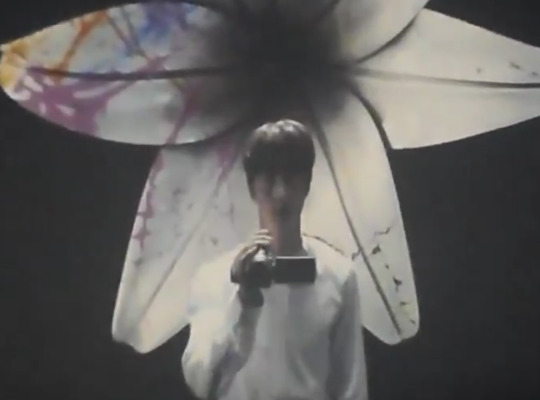
as we are all familiar: the general consensus is that the 6 flower petals represent the rest of bts’ members (re: everyone EXCEPT jin), and it’s often agreed upon that he’s “filming” the boys because 1) he’s dead and dreaming them up or 2) he’s recalling all his memories with them or 3) the boys are dead and he’s the only one alive or 4) tbh pick ur poison i’m not gonna make this post a breeding ground for HYYH theory discourse, but i’m down to talk elsewhere !!!!
this part isn’t particularly groundbreaking, but it’s the first direct link to the young forever M/Vs
HOWEVER !!!!the difference arrives when the shot cuts to what jin is filming; it seems that there are seven people in frame? (this is at 0:52 in the video)

which leads me to believe that, because WINGS is a continuation of young forever, it makes sense that jin manages to find his way back to the boys - something that connects itself to a bs&t theory i have. the general rundown of my interp is the (6) members are literally works of art in the museum, and when jin starts to “crack” at the end of the M/V, it’s because he joins them as an art piece; they’ve drawn him in (kissing tae’s statue, the hands over his eyes, tae covering up jin’s face with his hands, jin stopping to stare at the painting near the beginning) and this is how jin ends up joining the rest of the group
2) the focus shot of jungkook

again, parallels to run, where there’s a solo part that’s just him staring into the cam (once after his fight with yoongi, again at the end of the M/V). he’s staring into jin’s camera and, subsequently, at jin himself - likely wondering 1) why he isn’t with the rest of the group or 2) who he is/what he’s doing
from a cinematographic point of view, this is probably just a cool transition shot, since the members all need their solo screentime + the cuts won’t be too sudden, but i like the repeating themes they’ve been using :0
3) taehyung's wings
in the beginning of the video, taehyung is seen matching himself up to a pair of wings in a box behind him. the glass to his left side says “YOUTH”
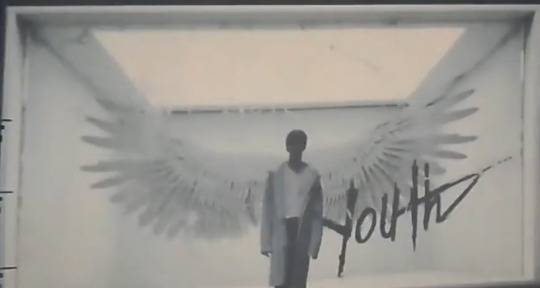
the main thing to note here is that the feathers are white, compared to the thousands of other shots of tae with black wings (M/V, trailers, teasers, you name it). once he breaks the box to access them (AKA shattering youth or the illusion thereof), taehyung strips away his innocence - similar to when he killed his father “i need you”
white is a color that often symbolizes purity/chastity while black is. well. has evil and sinister connotations, as well as a demonic undertone, if you want to get biblical (hold onto this thought now; it’ll return with my jimin analysis), so it makes sense they’d use this color palette with taehyung’s storyline
4) hoseok’s wings
hoseok is seen eating his snicker bar (lov my man omfg), but after he takes a bite, the wall behinds him shatters into color. in the first round, the camera pulls tighter in on him and the word “placebo” can be seen clearly behind hobi
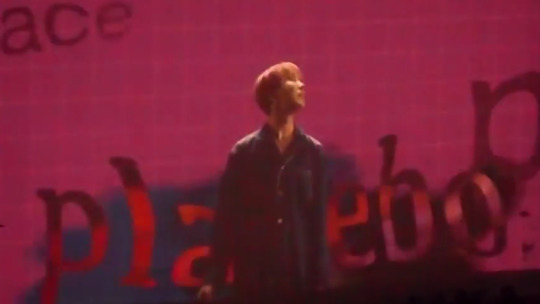
i think this directly references the placebo effect, in which one’s condition improves/degrades depending on your mindset of your illness. in both eras, HYYH and wings short films, hoseok is often depicted dealing with drugs, pills, and medication. he and jimin are even seen in a hospital together (again, spanning both timelines), which leads me to believe that he’s using prescriptions to deal with the fact he’s suffering from something meds can’t cure. what is it? that’s a great question i only have vague answers to.
it could be the fact that he’s missing his friends/bts family? is (still) suicidal? trying to cope with their loss? his condition has worsened after losing jimin, which is why he is in a max safety cell with all those pills pouring in through the walls? listen, who knows? i sure don’t, but i can definitely talk about the next shot!!!!!!!!!!!
right afterwards, hoseok also gains a pair of wings, but notice they’re different than taehyung’s

these are his BME wings (they show up in his intro, u can go check it out if you want). his corrupted wings. his Bad Wings. and they come from the crossover of boy and evil.
boy = youth = wings
MEETS
evil = dark/cool toned colors (evil) = bony (feather) structure
^ is why his wings look the way they do (thank u @ opening shot of taehyung’s YOUTH/wing box haha)
5) progression of their lives/jimin’s solo shot
there are five (?) consecutive scenes with all the boys goofing off together. the vid quality’s pretty low so i can’t tell who is who, but it seems like they’re all just chilling. hanging out. being bros. etc. so i’m lead to believe the first three “windows” of light (bc each scene is separated by a long black column) are before any bts M/V timeline. then you have jihope in a hospital/nondescript room together - directly related to run and jimin’s wings short - in opposite beds, being playful like their pillow fight in run.
last there is the truck with all 6 of the boys in the trunk from run
these shots lead up to jimin in his blindfold, holding an apple in his hand (seen clearer in the actual vid)
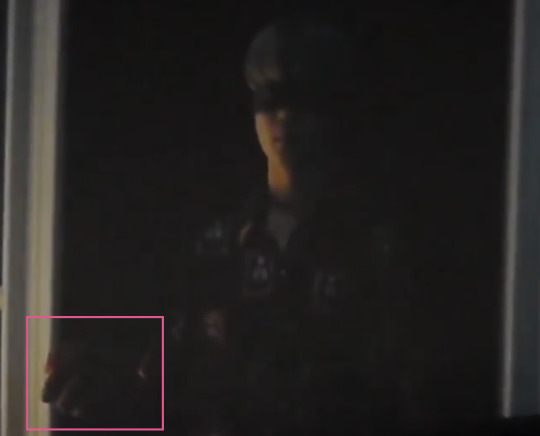

this is his costume from bs&t/his solo stuff/is part of “lie’s” concept. the blindfold could mean many things, so i’ll focus on the apple for now. in his promo shots, he’s surrounded by many apples, something i was always confused about, BUT I AM NO LONGER !!don’t worry!!!
as bts has said multiple times, bs&t is about boys who fall to temptation, and what better symbol of temptation than eve in the garden of eden - the first woman who is unable to resist the forbidden fruit? DAMN THAT’S RIGHT !!!!!!! you can have him holding an apple - the figurehead of eve failing to resist her temptations and, therefore, the way jimin/bts fails to resist their temptations. this is why jimin’s holding the fruit in all his shots lol. it’s because he’s already picked the apple off the tree & “fallen” prey to his desires
6) Bangtan and the Curious Case of Looking Up
at the end of the video, right after jimin takes off his blindfold, the VCR cuts to bts all looking up at the sky, faces illuminated. this is likely a symbol that they literally “see the light” - a popular term that means someone has died and is crossing over to the other side/heaven/the afterlife. this makes sense, because of the HYYH theories imply everyone is dead or ends up dying (since young forever implies bts meets up in heaven)
the thing that sets this apart for me is the fact that EVERYONE BUT JIN IS LOOKING UP @ THE SKY. jin is the first member to get focus during this scene; he’s just standing there staring straight at the camera, a motif that showcases their character is detached from the rest of the members in bts’ M/Vs. it’s like they’re not quite there, even though one member may appear alongside everyone else (jin & jungkook in HYYH).
here: jin’s seen looking side to side, even a little upwards, but never completely like the rest of the members

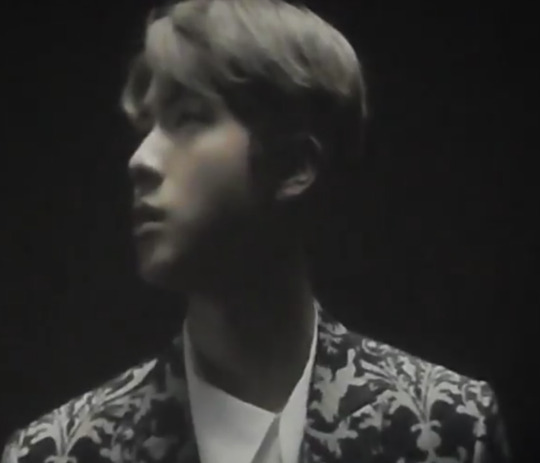

besides his dashing good looks and impeccable suit taste, jin seems worried. he seems to be obviously, obviously worried. however, the other members don’t have this expression on their faces; they’re at varying levels of peace or happiness or excitement when they each get their solo cut (i’m not gonna put 6 pics after jin’s bc that would just take too much room due to tumblr’s poor image spacing rules rip, but they’re all in a thread in that link credit up top)
jin looks like he’s confused and baffled and searching for something (or someones ;;)))) amiright or amiright) during this scene - a motif that corresponds with the HYYH/my bs&t theory of jin being alone in some way, shape, or form
“WAIT” you say “BUT JIN DOES LOOKS UP AT THE END !!1!11!1!!!” you say
“yes my friend !!” i say
you are absolutely right. he is eventually seen looking up into the light like the other boys. however there are two things of things to notice: first is that he’s never looking up completely (comparison below)

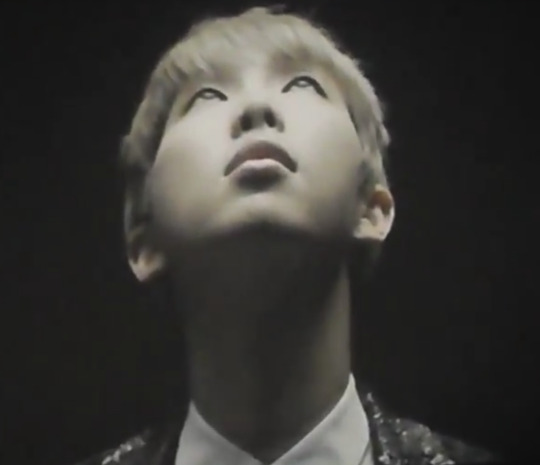

and right as he fades into the background - he starts lowering his head (it’s easier to see this when the actual video is playing) back down to the camera - his expression still troubled. again, this shows he’s still separated from the rest of bts, even though he seemed to be very close to joining them.
so maybe he’s still dead. maybe he’s still trapped and he’s looking for a way out and his distress comes from knowing his members are going Somewhere Without Him, but i guess what happens next is on bts.....
i hope they keep going with this storyline; i’d love to see where it goes :0
#bts#bts theory#bangtan#lmao what else should i tag this as???? tbh idk let's just hope at least someone finds this interesting !!!!
337 notes
·
View notes
Text
On Chronophobia and ADHD – RB with Hestia Peppe
RB: hey, i think i just self-diagnosed with ADHD, am i right in thinking that's something you know about? would welcome any recs you might have for reading/resources
.
RB: (it would explain so muchhhh)
.
RB: (also wondering about the rel between ADHD and trauma)
.
HP: Oooh yes! ADHD is definitely the errr paradigm I am working with right now if that's a way to think about it.
.
HP: I am actually amazed by how practically useful it has been to think in these terms.
But I will say in terms of research/resources stuff is thin on the ground and mixed up with a lot of neurocognitive research which i find quite dodgy in places, not to mention the (very american) pharmaceutical agenda.The best stuff i found has been self advocacy descriptive personal account stuff, and that has been very much a process of reading between the lines.
Basically, people with ADHD tend to at least appear quite ‘high functioning’ (not an ideal phrase because hierarchies) so go undetected often, and then its very very stigmatised, i would say, in that often symptoms or traits are judged in moral terms. The most important sort of secondary ideas i have found are about Rejection Sensitivity Dysphoria, and anxiety as a hugely comorbid secondary issue which is more likely to be treated than the ADHD itself.
The relationship to discipline and goal-setting is formative, as is chronophobia or a traumatised relation to time, and sometimes memory. The neurocognitive hypothesis is that it’s a problem in the dopamine cycle, so process is more fulfilling than completion of work; but i am super skeptical about neurotransmitter theories.
.
HP: As far as its relation to trauma goes, i would say it probably renders us more vulnerable to CPTSD. Lack of diagnosis or 'management' of ADHD leads to problematic coping mechanisms, leading possibly to abusive or addictive behaviours or on the other end vulnerability from a lack of or funky interpersonal boundaries. But whether anything is causal/symptomatic or comorbid seems always particularly hard to tell with ADHD, partly because of the non-typical relation to time.
HP: The neurocognitive hypothesis is that it’s a problem in the dopamine cycle, so [that] process is more fulfilling than completion of work, but i am super skeptical about neurotransmitter theories.
.
HP: On the plus side, [my] university and NHS [practitioners] have both been really encouraging about seeking help for it and getting a psychiatric diagnosis, which i am interested in, tho will no doubt have its downsides.
Most important, i think, is that mental health problems are treated in the context of ADHD as a constitution, rather than [in isolation], and i think that would go for trauma stuff too. Apparently ADHD folks have less success with SSRIs than others.
I think a body focused/somatic approach [is] v. v. productive, for both ADHD and trauma.
Rejection Sensitivity Dysphoria [also] seems key. It’s the idea that the emotional impact of rejection is almost irrationally high in many ADHD folks, but [then again] this may be a traumatised relation from the stigma of ADHD, and literally being reprimanded more often than neurotypical folks, rather than being an essential difference. So if there's an interaction with trauma specific to ADHD it might be related to emotional response to external stimuli being higher.
.
RB: gosh, yea.
.
HP: Sorry so much.
.
RB: Wondering how receptive my gp would be to my requesting an adult diagnosis
.
HP: My GP was like ‘yes, will refer u immediately’, but that’s with a recommendation from an Ed Psych which uni paid for. *UPDATE: NHS maybe aren’t doing this as quickly as i thought, so it remains to be seen if they follow through; and university seems to just be sending me through as many hoops as possible, lots of assessments, minimal support systems.
.
RB: ok
.
RB: i saw this on Twitter – ‘ADHD Explained Using Comics’ by Dani Donovan,1
and, like, so much of it is me. ,2So much. idk what chronophobia is but def. have weird relationship with time. Very weird.
.
HP: I have sort of made up chronophobia but am sure its a thing.
..
RB: 'comorbidity'
.
RB: i feel lost in time.
.
HP: It seems to me the best stuff around is DIY stuff exactly like the comics u link to
.
RB: also – trouble starting anything; trouble finishing without hard external deadlines – so me.
.
RB: why i never write
.
HP: I think these are like the defining traits tbh
.
RB: even tho i want/need to be writing
.
RB: + procrastinating
.
HP: Comorbidity is the creepiest word
.
RB: as described ^^
HP: Same!
RB: do u medicate for it, may i ask? seems like mindfulness / meditation cld really be helpful
RB: i had an insane year on citalopram
HP: In America they see it as essential to medicate for it from a v early age but i am like v v v skeptical
.
RB: sertraline seemed better
.
HP: I took Prozac for 5 years; it didn’t do much except make me sleepy and a bit ok with shit life, but for ADHD it’s Ritalin or Vyvanse, so treatment with low constant dose of stimulants (*sometimes also something called dopamine blockers, but I don't know the details).
RB: ok; so, like coffee? just on my risky 2nd cup.
HP: I dont myself want this prescription.
HP: Am sure mindfulness etc v. good, but i do think body-focused methods best.
RB: ok
HP: I read this Twitter by Erynn Brook (sp?), and she advocates meds but also talks a lot about building in good coping mechanisms like how you organise yrsrlf in space/time in ways that work for u.
RB: yea; more interested in strategy
HP: So yeah strategy v. key.
RB: hey thanks so much, also in as much as i may unconsciously have posited u as gatekeeper. couldn’t have hoped for a more helpful reply.
HP: No worries! It’s good talking to other people about it cos the grand narrative of it is well shaky
HP: One thing i have worked out is that it’s all just emerging now so u can’t really gatekeep it, thank fuck. Glad to be helpful always. Check out Erynn Brook and remember being kind to yourself cos probably u havent been being if u just got to this point.
[time passes]
RB: hey, i'd really like to hear a bit more about your thinking on chronophobia;
it stayed with me as a strong motif. felt so 'full' when you said it it took me a while to realise i hadn't asked u to describe it.
HP: Yes I would love to see you and talk about all this stuff. I have thoughts tjoughts thought ... Google searching ‘Chronophobia’ brings up this book from MIT about art in the 60s:
https://mitpress.mit.edu/books/chronophobia. It appears to be also a term in use in psychology/self help; is in wiktionary, and appears to mean the obvious: fear of the passing of time. Associations with incarcerated people, particularly, suffering from it and also anyone suffering from heightened stress and anxiety. Searching chronophobia + ADHD, there are plenty of hits, so, again, this seems a well-made connection. I’m also thinking about ‘Chrononormativity’, an idea i was first introduced to by my friend Helen Stuhr Rommereim, and which I think she gets from Elizabeth Freeman (possibly via Lauren Berlant), in relation to ‘queer time’ or a failure to achieve normative milestones in the time allotted, such as maturity, childbearing, marriage. Her paper on this is included in the documentation of a conference about Chris Kraus we both attended in 2013, which is where we met as we were on the same panel. 3
HP: Context in my work right now – all of this to do with ideas about speculation, past/present/future, chance/fate, resistance to goal/plan/target, not knowing what to do.
I’m currently doing some early/cursory research into the mythology of the fates (Ancient Greek and other cultures) as spinners, and thread as line; trying to parse linearity and how it might or might not relate to neurodivergence/neurotypicality. I like lines as a way of following or tracing, and also drawing as well as writing –thinking a lot about the work of Renee Gladman, who is interested in architecture and fiction (prose architectures), and works with drawing and writing and the relation between the two – so, also automatic and asemic writing. I also think a lot about Ariadne’s red thread in the labyrinth, and now that i am trying to learn to spin, how all threads are made of many tiny ones. This trying to spin has grown out of an old durational performance work i have done for years – so, durational performance, as a form, is part of this, maybe, for me. I always like the durational form, as it is more about setting up boundaries in space and then letting time happen than [it is about] existing in linear time. Chronophobia as anxiety about mortality, and control, or volition/agency; or the trace of subjectivity in the world (cf maybe tim ingold). Also, there are two types of time in the classical sense: Kairos (the now) and Chronos (history), or something like that. None of this is fact-checked, I must say.Tarot cards relating to time are: wheel of fortune, temperance, death, the hanged man.
HP: Not sure i am doing this right, but thought some context to the earlier conversation might be useful for orientation, at the same time as thinking about my own self-diagnosis of ADHD and how it relates to knowledge and action and intention and access. Not sure if you saw this on my Twitter, but I thought it was a very good overview of neurodiversity discourse as it stands: https://www.janinebooth.com/content/two-and-half-cheers-neurodiversity
RB: Thanks. You’re doing this very right, I’d say. Like somewhere back in the transcript there is a ‘gosh, yea’ of mine which stands in as a marker for the point at which my mind was blown, began to make new neural connections, bathed in a sort of speechless radiant awe for what you said; and this feels the same only more so, galaxy brain in mandelbrot – only grounded in and by your efforts to verbalise it and connect it with your work and that of others. That this is what you’re working on for your doctorate – I am awed and excited to know it. I would really like to be present when you perform. I’m really impressed by your articulation. I feel such a relieved shock of recognition for chronophobia as you describe it, as something I had begun to acknowledge and articulate internally, but never outside myself, verbally or otherwise; nor had any inkling that it might be tangled up with ADHD ... nor that it is something other people experience or know about, nor that you are working on it in this profound way. I feel less alone and am honoured that you shared this here with us.
RB: Also – ehheh! I saw today that we both liked this tweet
RB: Another highlight, for me, of today’s feed –
RB: I’m always keen for writers’ writing on technique, scanning in case I find a key there to my own outward articulacy and/or the means to vanquish distraction/avoidance. Just remembered when the poet Lucy Mercer said to me that as a writer, I’m a weaver. I was happy with that then and I am happy with it here, in this context. 4
HP: Hey! This is all so kind of you to say I am sort of overwhelmed. I can't believe i have even been paid for this already, so shout out to that. I made up chronophobia because i wanted a way to describe my fear of time. I dont think it was really to talk to anyone else about it. I looked it up afterwards when I mentioned it to you I guess i have really let you have it with the inner monologue. I looked it up after I mentioned it to you. I figured that this had, you know, happened before, that other people would already be using this word. And they are. As a sort of intra-post-script, it is important to say that in terms of ADHD I came to this knowledge or understanding after like 12 years working as a private tutor, and without the students I worked with in that time I don’t see how I would have got to this articulation, so immense gratitude and respect to them for the thinking we did together about how thinking and learning work for different people.
HP: I was going to email you and ask for a deadline today but in the end i didn't write any emails because i was just spinning yarn on the wheel. It’s an amazing process learning to do it. Like a truly never-has-to-end embodied action. I think it could be the best way to replace some obsessive Twitter scrolling. My dad totally gets it. He says singing while spinning, that's the thing, he's heard. I learnt how to learn things from him mostly. I think maybe both my folks have ADHD. It’s supposed to be super heritable.
HP: My mum's a doctor. That's maybe where I get the cavalier attitude to discussing stuff like this you are supposed to be an expert to be allowed to think about. I am absolutely not an expert except perhaps of my own experience. Which this is, but but i push it, i know that. tho I don’t want the meds, I absolutely want to stress i am not like totally against meds. Chemicals are fine and good. Like coffee or you know whatever works. I am just in favour of people being given the best possible understanding of any treatment they undergo. I feel like i wanna unwind my own coping mechanisms like manually. Maybe that's a perk of late diagnosis – for me, anyway.
HP: I have to stop now. I am in a park and it’s dark now. I was sitting in the park cos i was an hour early to get a lift from my friend because i was so worried about being late. It’s perfect timing though. If you like sitting in parks watching orange street-lamps through blossom as if they are the sunset like some kinda shook moth. Which I do. And then type super fast into a phone cos you know someone asked.
HP: Thanks xx
RB: <3
RB: Thank you
1 – https://Twitter.com/danidonovan/status/1100414551932030984
2
3 (http://www.metamute.org/editorial/books/you-must-make-your-death-public-collection-texts-and-media-work-chris-kraus )
4 mercer | ˈməːsə | noun British, chiefly historical a dealer in textile fabrics, especially silks, velvets, and other fine materials. (Oxford English Dictionary Version 2.3.0 (203.16.12))
0 notes